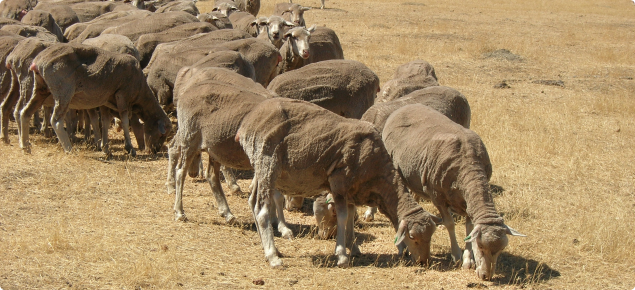What is grain overload?
Grain overload (acidosis, grain poisoning) occurs when cattle, sheep or goats eat large amounts of grain. The grain releases carbohydrate into the animal's rumen and this rapidly ferments rather than being digested normally. Bacteria in the rumen produce lactic acid, resulting in acidosis, slowing of the gut, dehydration and often death.
What causes grain overload?
Wheat and barley are the most common causes of grain overload, but it occasionally occurs with oats and lupins. Crushing or cracking of grain by a hammermill increases the likelihood of grain overload, because these processes result in quicker release of carbohydrates.
Cases are often seen when:
- stock are suddenly grain fed without being gradually introduced to the grain or pellets
- there is a sudden change in feeding regimen or in the grains being fed
- stock graze newly harvested paddocks (where there may be spilled grain or unharvested areas)
- stock get unplanned access to grain or pellets, such as around silos.
Which classes of stock are affected?
Cattle sheep and goats of any age can be affected if they eat more grain than they can digest normally.
Signs of grain overload:
- depressed appearance
- lying down
- diarrhoea
- dehydration and thirst
- bloating (of the left side of the abdomen)
- staggery or tender gait and 'sawhorse' stance
- deaths.
What are the treatments for grain overload?
Consult a veterinarian for a treatment plan, as treatment will vary according to the severity of the disease. Treatments include intravenous fluids, drenching with bicarbonate solution or milk of magnesia, intraruminal antibiotic injections, thiamine or steroid injections, and surgery for very valuable animals.
Following grain overload, the rumen lining takes up to six weeks to repair, so recovering animals will show poor growth rates during this time.
Some animals may develop secondary infections, including abscesses in the liver and other organs. These animals tend to become long-term poor doers and may need to be culled.
Welfare
Animals that appear very depressed after getting sudden access to bulk grain, and which are not immediately treated, will usually die. It is advisable to discuss individual animals affected like this with your private veterinarian or your local Department of Primary Industries and Regional Development, Western Australia (DPIRD) Field Veterinary Officer as many of these should be euthanased.
How can I prevent grain overload?
Grain overload can be prevented by gradually introducing animals to grain or pellets. The amount of grain and the time taken to adapt sheep or cattle to grain depends on:
- availability of hay and other feed
- time of year
- type of grain being fed
- aims of feeding (such as for weaners for sale or for lactating ewes).
Specific antibiotic products that selectively reduce the numbers of acid-producing bacteria in the gut are available on prescription from veterinarians. These make it safe to introduce grain more rapidly without a long conditioning process.
Some useful guidelines for preventing grain overload in stock are:
- Use oats and lupins in preference to, or before transitioning to, wheat or barley.
- During the introduction phase, feed grain daily.
- Introduce oats to sheep by starting with 50 grams on the first day, followed by increases of 50g per head per day until the required ration is reached.
- Ensure sheep always have access to roughage as well as fed grain.
- Introduce oats to cattle by starting with 500g per head per day, followed by increases of 500g per head every fourth day until the required ration is reached.
- When feeding grain to cattle for production ensure a good quality source of hay or silage is always available and that it makes up at least 20% of the ration (unless feeding a complete ration where the roughage and grain are mixed).
- To transition to wheat or barley from oats, increase the wheat or barley portion by 25% of the oat ration every five days over 16 days. For example, if the current oat ration is 500g, start by adding 125g of wheat or barley to every 375g of oats.
- Monitor your herd or flock for signs of scouring, depression, lethargy and lameness, which will indicate that the amount of grain being fed is being increased too fast.
- Check pulpy kidney vaccinations are up to date and vaccinate if necessary before grain feeding.
Diseases with signs that may resemble grain poisoning:
- polioencephalomalacia
- salmonellosis
- pulpy kidney (enterotoxaemia)
- pregnancy toxaemia
- hypocalcaemia
- lupinosis.
If you are in doubt about the signs your stock are displaying or you see unusual disease signs or multiple deaths in your stock, call your veterinarian or your local DPIRD veterinary officer, or the Emergency Animal Disease hotline on 1800 675 888.
More information
For more information contact your local private veterinarian or local DPIRD Field Veterinary Officer.

